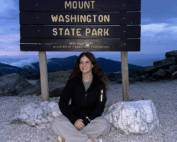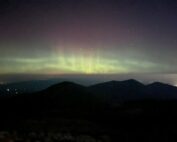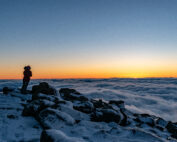Special Relativity and Mount Washington
2018-07-09 15:42:43.000 – Emily Tunkel, Summer Intern
Freshman year, second semester, I took a course called “Introduction to Relativity and Quantum Mechanics” in which we discussed an experiment performed by David Frisch and James Smith in 1963. Frisch and Smith were looking to measure the effect of time dilation on mu-meson particles. Time dilation, an effect of special relativity, basically describes what happens if you throw a clock fast enough: It will start to run slow. The factor of this time change is generally pretty small because it relates the object’s velocity to the speed of light (3*108 m/s). The only way to have a significant time difference is for the object to be moving incredibly fast — generally around 0.9 times the speed of light.
A mu-meson, also called a muon, is a type of elementary particle that is created by protons from the sun getting broken apart by the atmosphere. These muons have a very short half-life – only two microseconds. If we imagine these muons coming down from the atmosphere, half of them would die in two microseconds, another half in another two microseconds, and so on.
Frisch and Smith wanted to see how fast the muons were travelling, so they set up two stations; one at sea level in Cambridge, Massachusetts, and one at 6,288 feet on top of Mount Washington.
From their experiment, which took about one hour, they found that the muons decayed at only about 0.7 microseconds – if we imagine that the muons were clocks, they would be running slow by a factor of nine. The muons were moving at a speed of 0.995 times the speed of light, which changed how long Frisch and Smith observed their half-life!
This is a very brief overview, and I recommend for more information you take a look at their original paper “Measurement of the Relativistic Time Dilation Using mu-Mesons” (1963) or the short movie Time Dilation: An Experiment with Mu Mesons published by MIT.
The Cosmo Shack, a small wooden cabin on the observation deck of MWO, measures the number of muons that are rained down from the atmosphere and compares it to ones measured at the University Of New Hampshire. This project has been on-going for nearly 60 (!!) years and can be used to monitor ejections of mass from the Sun’s corona as well as solar flares. While the Cosmo Shack is not the same one that Frisch and Smith used, the experiments are similar in their detection parameters.
Emily Tunkel, Summer Intern
From Weather Observer to Intern, to Observer Again
From Weather Observer to Intern, to Observer Again By Madelynn Smith As I rode in the backseat of our Obs van up the Auto Road for the first time as a full-time employee at
From Mountains to More Mountains
From Mountains to More Mountains: This Time with Stronger Winds By Alyssa Bélanger On the observation deck in high winds. Hello there! My name is Alyssa Bélanger and I am a fall
From Summit to Sign-Off: My Farewell to the Rockpile
From Summit to Sign-Off: My Farewell to the Rockpile By Amy Cotter Enjoying my last Mount Washington sunset (for now) on September 13, 2025. After two incredible years with the Mount Washington




